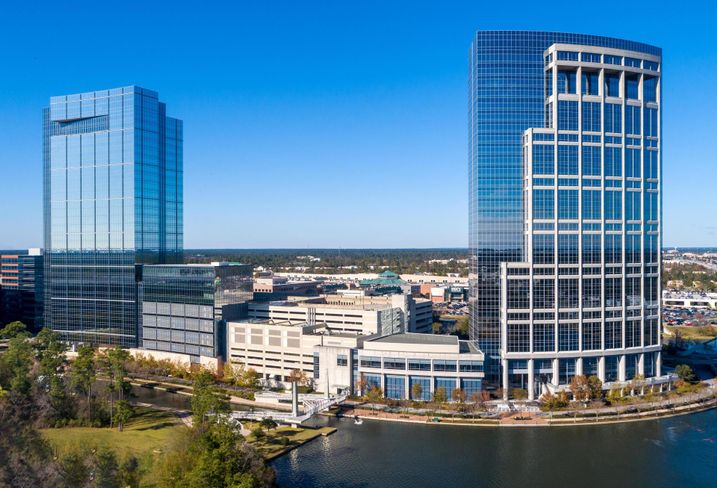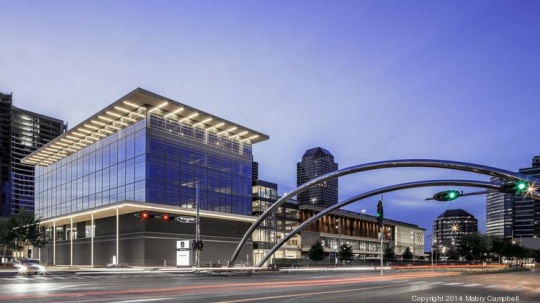Martin, Disiere, Jefferson & Wisdom, which has been a tenant in downtown Houston’s historic Esperson Building since the law firm was founded in 2000, expanded its footprint to 42,000 square feet, according to real estate brokerage Newmark Knight Frank.
Common Desk, a Dallas-based coworking company, leased 29,093 square feet at 3040 Post Oak in the Lakes on Post Oak near the Galleria for its second Houston location. Ryan Barbles and Mathew Volz of Stream Realty Partners represented the landlord, MetLife Investment Management.
Common Desk, which offers an all-inclusive model in its monthly membership, recently leased 25,000 square feet in The Block, a warehouse redevelopment project at 2339 Canal St. in the East End for its Houston debut in late summer 2020. The Galleria location, which is planned to open in early fall 2020, will offer its Fiction Coffee in-house brand, custom art, and finishes throughout the space, private offices for growing teams, hospitality suites for enterprise users and full-service workspace amenities.
Martin Disiere Jefferson & Wisdom expanded and extended its lease for 42,000 square feet at downtown’s historic Esperson Building. The law firm, which previously occupied 39,000 square feet on four floors, consolidated to two floors that have been built out with a traditional yet modern design. Reginald Beavan III and Joshua Brown of Newmark Knight Frank represented the tenant, while Cameron Management represented the landlord in-house. The Houston-based law firm, which has other offices in Dallas, Austin, and San Antonio, has been a tenant of the Esperson Building since it was founded in 2000.
MobisoftInfotech leased 3,998 square feet at 1811 Bering Drive. Larry Vickers of Tarantino Properties represented the landlord. William McCarthy with Finial Group represented the tenant.
Craters & Freighters renewed a 14,165-square-foot industrial lease at 6100 West by Northwest Blvd. Chris Caudill of NAI Partners represented the tenant. Boone Smith and Garret Geaccone with Stream Realty represented the landlord, Agellan Commercial REIT.
Protec Equipment Resources, a provider of sales and rentals of electrical test and measurement equipment, leased an 8,000-square-foot building at 14251 Gulfstream Park Drive in Webster. Coe Parker of Cushman & Wakefield represented the landlord, Enviro Building Systems. Melissa Gerber Brams of Gerber Realty represented the tenant.
Dover Precision Components, a provider of products used in rotating and reciprocating equipment, is constructing a nearly 12,000-square-foot Innovation Lab in Pearland’s Lower Kirby District, according to the Pearland Economic Development Corp. The facility, just north of the company’s 150,000-square-foot manufacturing and operations center at Spectrum Boulevard and Hooper Road, will open in the second quarter of 2020.
Capital Title of Texas has leased 3,000 square feet of office space at 27008 Northwest Freeway, Cypress, from Cymill Partners. Ashley Strickland and Nick Ramsey of NewQuest Properties represented the landlord. Adam McAlpine of McAlpine Interests represented the tenant.
Lake Management Services, a company specializing in the construction, consulting and maintenance of lakes and ponds, leased 15,300 square feet of industrial space at 4318 Bluebonnet Drive. Jake Wilkinson and Chris Caudill of NAI Partners represented the tenant. Clay Pritchett of NAI Partners represented the landlord, Martinez A&M Investments.
Southern Reformed Seminary purchased a 2-acre property with 7,500 square feet of buildings at 26111 Beckendorff Road, Katy. The seminary plans to relocate from its current location off Dacoma and U.S. 290 in northwest Houston. Keith Towne of Re/Max Metro represented the seller. Ashley Casterlin of Davis Commercial represented the buyer.
Gridforce Energy Management leased 12,702 square feet at 1301 Fannin. John Luck, Joshua Brown, Reggie Beavan III and Andy Iversen of Newmark Knight Frank represented the tenant.
Premier Construction & Development purchased a 1.38-acre tract at Shadow Creek Parkway and Kingsley Drive, Pearland. Brad LyBrand and Brad Elmore of NewQuest Properties represented the seller, A-S 143 SC Ranch LP.
Domain Communities, a Houston-based multifamily firm founded by James D. Golden, purchased the 300-unit Iron Rock Ranch apartments in Austin. John Fenoglio of CBRE arranged to finance from New York-based MF1.

/arc-anglerfish-arc2-prod-dmn.s3.amazonaws.com/public/5MYUMFHWJFGDPN46RK54FOIQ6M.jpg)



 Commercial real estate giant JLL announced plans to purchase Peloton Commercial Real Estate Thursday. The merger will effectively pull Peloton’s Dallas and Houston offices into JLL’s agency leasing and property management business lines. Ricky Bautista, Unsplash Downtown Dallas As part of the merger, more than 130 Peloton employees will be joining JLL. The acquisition is expected to close in the next few weeks, with Peloton co-founding partners Joel Pustmueller and T.D. Briggs and JLL’s Jeff Eckert leading the statewide integration efforts. Pustmueller and Briggs will work directly with the Dallas-Fort Worth and Houston offices while Eckert will oversee Austin, San Antonio, and Dallas-Fort Worth as the teams integrate. Peloton Property Management partner John Myers will be named regional leader of property management for DFW. “This is a momentous step in our journey to become a market-leading player in Texas,” said David Carroll, JLL market director for the South Central Region. “With the exceptional growth we have seen in those markets, Peloton’s position as a leading provider of leasing and property management services will greatly enhance our business capabilities and breadth of services. Just as importantly, we look forward to working with a team of professionals that share JLL’s strong commitment to collaboration and culture.” JLL has a long history of growing via mergers and acquisitions, including closing the $2B acquisition of HFF July 1. One of its most notable acquisitions in Texas was bringing The Staubach Co., led by Dallas Cowboys elite quarterback Roger Staubach, into its fold in 2008. Peloton is a leasing and property management firm that launched in 2002. It manages or leases more than 25M SF for clients.
Commercial real estate giant JLL announced plans to purchase Peloton Commercial Real Estate Thursday. The merger will effectively pull Peloton’s Dallas and Houston offices into JLL’s agency leasing and property management business lines. Ricky Bautista, Unsplash Downtown Dallas As part of the merger, more than 130 Peloton employees will be joining JLL. The acquisition is expected to close in the next few weeks, with Peloton co-founding partners Joel Pustmueller and T.D. Briggs and JLL’s Jeff Eckert leading the statewide integration efforts. Pustmueller and Briggs will work directly with the Dallas-Fort Worth and Houston offices while Eckert will oversee Austin, San Antonio, and Dallas-Fort Worth as the teams integrate. Peloton Property Management partner John Myers will be named regional leader of property management for DFW. “This is a momentous step in our journey to become a market-leading player in Texas,” said David Carroll, JLL market director for the South Central Region. “With the exceptional growth we have seen in those markets, Peloton’s position as a leading provider of leasing and property management services will greatly enhance our business capabilities and breadth of services. Just as importantly, we look forward to working with a team of professionals that share JLL’s strong commitment to collaboration and culture.” JLL has a long history of growing via mergers and acquisitions, including closing the $2B acquisition of HFF July 1. One of its most notable acquisitions in Texas was bringing The Staubach Co., led by Dallas Cowboys elite quarterback Roger Staubach, into its fold in 2008. Peloton is a leasing and property management firm that launched in 2002. It manages or leases more than 25M SF for clients.



